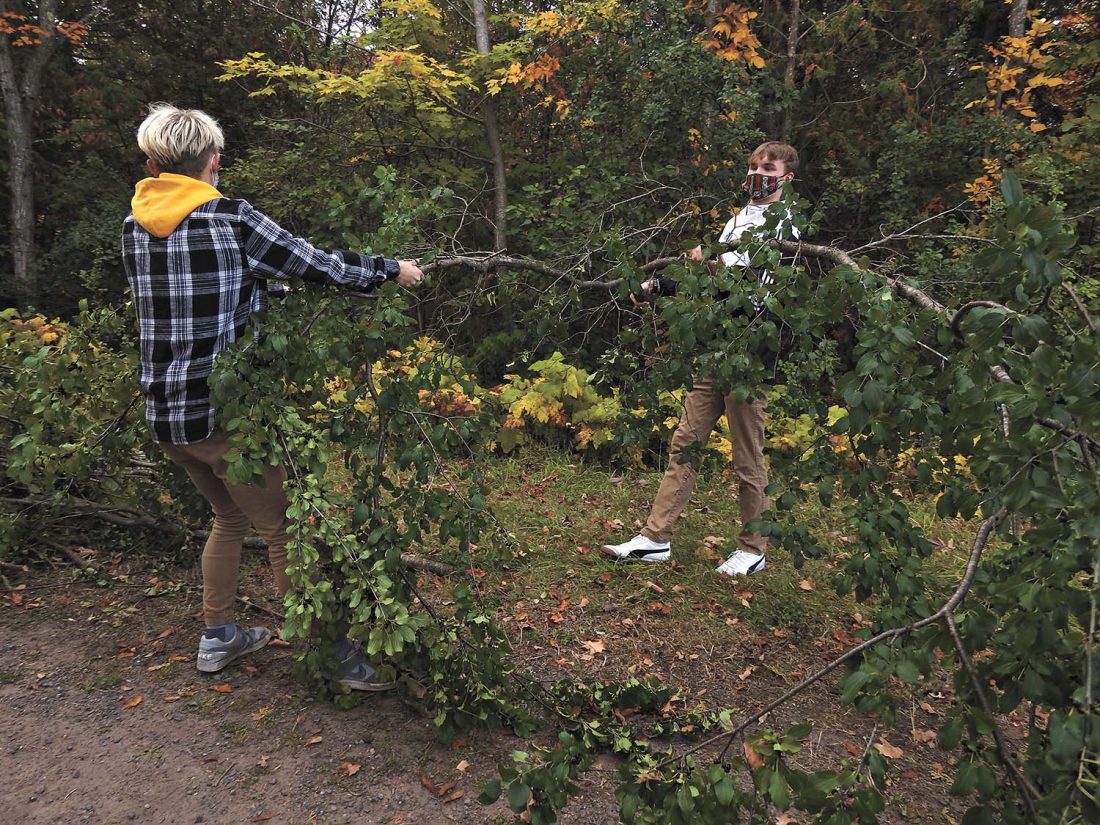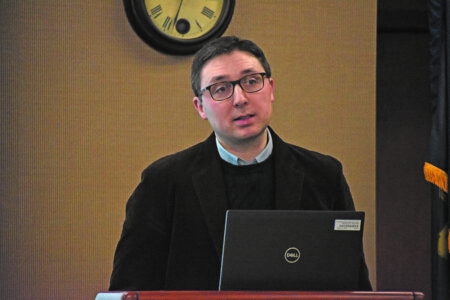Houghton students pull buckthorn

Garrett Neese/Daily Mining Gazette Houghton High School 11th-grader Gavin Russell and 12th-grader Sam Rosemurgy carry out a buckthorn tree while helping to remove invasives from the Michigan Tech Trails as part of their environmental science class.
HOUGHTON — When learning about invasive species, Houghton High School students don’t have to go far to see real-world examples.
Students in Sarah Geborkoff’s environmental science class spent Friday morning pulling invasive common buckthorn trees growing near the trailhead of the Michigan Tech Trails, behind the high school parking lot.
The class is working with the Keweenaw Invasive Species Management Area (KISMA), which has been combatting the spread of invasive species around the area. The activity is part of the environmental science class’s unit on invasive species and their cost to society, which is over $1.4 trillion a year, Geborkoff said.
Hands-on projects are important for students, particularly now, Geborkoff said. It also has relevance to the students in an area where natural resources are so important, she said.
“When we can have the kids actually working on a project. I think the concepts hit home harder, and they realized that this really is pertinent to their own lives and our own community in terms of helping to spread awareness of invasive species and other things that impact our natural resources here,” she said.
It feels great to be contributing, said Houghton High School 11th-grader Allie Waara.
“You go to math class, and then you go and help the environment,” she said. “Doing this in school, it’s nice to have a break from school, but you’re doing something productive, and even more productive in your community.”
The buckthorn produces fruit that resembles a cherry and has similar leaves, Geborkoff said. But those berries are darker. Buckthorns can also be distinguished by a yellowish appearance when the bark is scraped off. And as the name implies, there are thorns.
KISMA got a grant in 2017 to start monitoring the spread of buckthorn on the Tech Trails, said KISMA coordinator Sigrid Resh. Since then, they’ve developed a complete survey, mapping out the hotspots and places with adult fruiting trees. Geborkoff’s class, as well as volunteers from Michigan Tech and the community, have helped to remove them.
Buckthorn isn’t as prevalent on the lower part of the trails, which have the competitive ski loops and mountain-biking trails, Resh said.
“When my crews go through there when they’re mapping, when they find a individual, they just remove it right away, so it doesn’t start up a whole new population of invasives,” she said.
The biggest concentration is on the upper part, which has been disturbed by roads and mining operations.
Other invasives are helping the spread. Trees that make up the overstory are being felled by emerald ash borer. Those let in sunlight, allowing buckthorn to proliferate even more.
After they map, Resh’s crews come back to areas with seed trees like the ones Geborkoff’s class was eliminating. That is crucial in stopping the spread, Resh said.
“Birds are picking up these seeds, flying all over the Tech Trails and city and dropping them, and then they get new populations,” she said.
Last year, Resh obtained a grant that allowed her to replace the invasives with trees she planted last fall. Due to COVID-19, this year’s tree order was canceled. Resh hopes to resume next year.
“Meanwhile, we have a lot of space that’s being taken up by invasives, habitat that’s been taken up by invasives, and we will get rid of those as much as possible, so we have space to plant the natives we want growing there instead,” she said.
After identifying the buckthorn, students remove it, leaving about six inches of stump. They then sealed off the top with a bag and ziptie. Otherwise, it’ll sprout “like a hydra head,” Waara said.
“It’s pretty simple,” Waara said. “Anyone can do it.”
And more people should be, Resh said. In addition to organized activities, Resh also hopes to see hikers and others take action to remove invasives like buckthorn when they see them. For help identifying them, she said, they can contact KISMA at kismaup@gmail.com.
Resh also pointed to the Woody Invasives of the Great Lakes Collaborative website, at woodyinvasives.org. That has a variety of informational materials, including advice on how to recognize and get rid of common invasive species.
Until the class, Waara hadn’t realized how much buckthorn there was locally, and what people could do to remove it.
“I can only imagine how incredibly long it’s going to be to do this whole thing,” she said.
Looking at the overall situation across the Keweenaw, Resh admits to feeling overwhelmed. Then she reminds herself they’re chipping away a little at a time. Keeping invasives out of the Keweenaw entirely might be a lost cause without some sort of biocontrol, she said, but it’s worth working hard to preserve the trail systems and natural areas.
“When I have this kind of thing happening where I have a team of students who are willing to put the time in and I keep having that happen week after week or year after year, I know that we can start getting a good dent,” she said.






